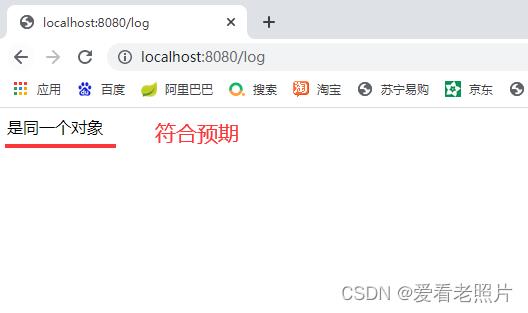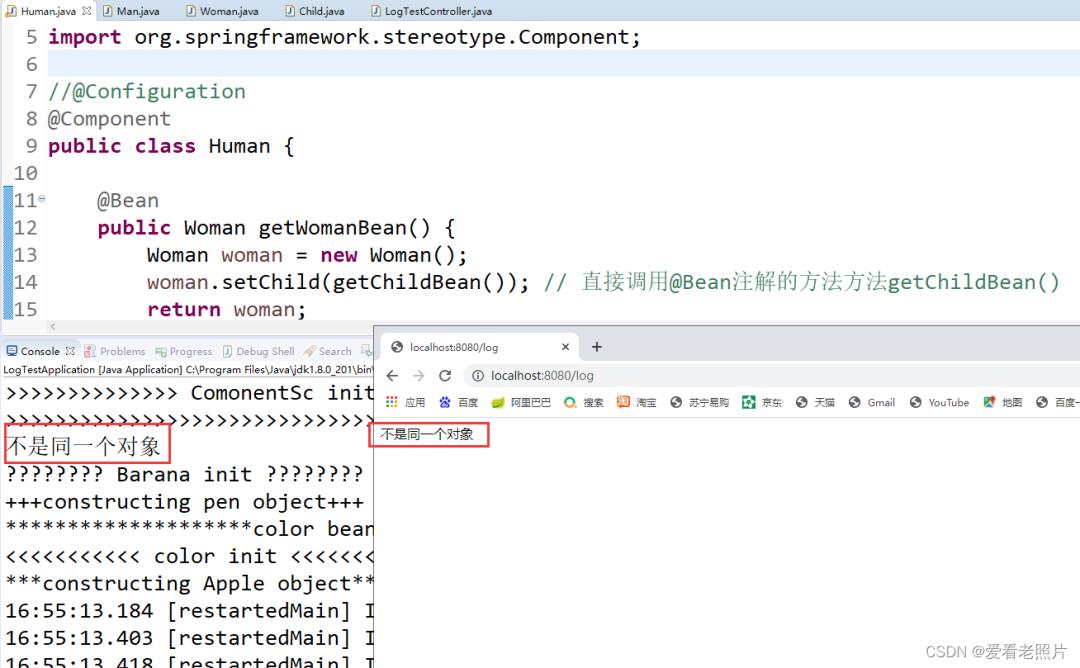面试官:@Configuration 和 @Component 注解的区别?大部分人都会答错!
Posted Java技术栈
tags:
篇首语:本文由小常识网(cha138.com)小编为大家整理,主要介绍了面试官:@Configuration 和 @Component 注解的区别?大部分人都会答错!相关的知识,希望对你有一定的参考价值。
一句话概括就是 @Configuration 中所有带 @Bean 注解的方法都会被动态代理,因此调用该方法返回的都是同一个实例。
理解:调用@Configuration类中的@Bean注解的方法,返回的是同一个示例;而调用@Component类中的@Bean注解的方法,返回的是一个新的实例。
注意:上面说的调用,而不是从spring容器中获取! 见最下面的示例 1 及 示例 2
下面看看实现的细节。
@Configuration 注解:
@Target(ElementType.TYPE)
@Retention(RetentionPolicy.RUNTIME)
@Documented
@Component
public @interface Configuration
String value() default "";
从定义来看, @Configuration注解本质上还是@Component,因此 <context:component-scan/> 或者 @ComponentScan 都能处理@Configuration注解的类。
@Configuration标记的类必须符合下面的要求:
- 配置类必须以类的形式提供(不能是工厂方法返回的实例),允许通过生成子类在运行时增强(cglib 动态代理)。
- 配置类不能是final 类(没法动态代理)。
- 配置注解通常为了通过
@Bean注解生成 Spring 容器管理的类, - 配置类必须是非本地的(即不能在方法中声明,不能是 private)。
- 任何嵌套配置类都必须声明为static。
@Bean方法可能不会反过来创建进一步的配置类(也就是返回的 bean 如果带有@Configuration,也不会被特殊处理,只会作为普通的 bean)。
@Bean 注解方法执行策略
推荐一个开源免费的 Spring Boot 最全教程:
先给一个简单的示例代码:
@Configuration
public class MyBeanConfig
@Bean
public Country country()
return new Country();
@Bean
public UserInfo userInfo()
return new UserInfo(country());
相信大多数人第一次看到上面 userInfo() 中调用 country()时,会认为这里的 Country和上面@Bean方法返回的 Country 可能不是同一个对象,因此可能会通过下面的方式来替代这种方式:
@Autowiredprivate Country country;
实际上不需要这么做(后面会给出需要这样做的场景),直接调用country()方法返回的是同一个实例。
@Component 注解
@Component注解并没有通过 cglib 来代理@Bean 方法的调用,因此像下面这样配置时,就是两个不同的 country。
@Component
public class MyBeanConfig
@Bean
public Country country()
return new Country();
@Bean
public UserInfo userInfo()
return new UserInfo(country());
有些特殊情况下,我们不希望 MyBeanConfig被代理(代理后会变成WebMvcConfig$$EnhancerBySpringCGLIB$$8bef3235293)时,就得用 @Component,这种情况下,上面的写法就需要改成下面这样:
@Component
public class MyBeanConfig
@Autowired
private Country country;
@Bean
public Country country()
return new Country();
@Bean
public UserInfo userInfo()
return new UserInfo(country);
这种方式可以保证使用的同一个 Country 实例。
示例 1:调用@Configuration类中的@Bean注解的方法,返回的是同一个示例
第一个bean类
package com.xl.test.logtest.utils;
public class Child
private String name = "the child";
public String getName()
return name;
public void setName(String name)
this.name = name;
第二个bean类
package com.xl.test.logtest.utils;
public class Woman
private String name = "the woman";
private Child child;
public String getName()
return name;
public void setName(String name)
this.name = name;
public Child getChild()
return child;
public void setChild(Child child)
this.child = child;
@Configuration类
package com.xl.test.logtest.utils;
import org.springframework.context.annotation.Bean;
import org.springframework.context.annotation.Configuration;
import org.springframework.stereotype.Component;
@Configuration
//@Component
public class Human
@Bean
public Woman getWomanBean()
Woman woman = new Woman();
woman.setChild(getChildBean()); // 直接调用@Bean注解的方法方法getChildBean()
return woman;
@Bean
public Child getChildBean()
return new Child();
测试类 I
本测试类为一个配置类,这样启动项目是就可以看到测试效果,更加快捷;也可以使用其他方式测试见下面的测试类 II
package com.xl.test.logtest.utils;
import org.springframework.beans.factory.annotation.Autowired;
import org.springframework.context.annotation.Configuration;
@Configuration
public class Man
@Autowired
public Man(Woman wn, Child child)
System.out.println(">>>>>>>>>>>>>>>>>>>>>>>>>>>>>>>>>>>>>>>>>>>>>>>>>>>>");
System.out.println(wn.getChild() == child ? "是同一个对象":"不是同一个对象");
启动项目,查看输出结果:

测试类 II
package com.xl.test.logtest.controller;
import org.springframework.beans.factory.annotation.Autowired;
import org.springframework.web.bind.annotation.GetMapping;
import org.springframework.web.bind.annotation.RestController;
import com.xl.test.logtest.utils.Child;
import com.xl.test.logtest.utils.Woman;
@RestController
public class LogTestController
@Autowired
Woman woman ;
@Autowired
Child child;
@GetMapping("/log")
public String log()
return woman.getChild() == child ? "是同一个对象":"不是同一个对象";
浏览器访问项目,查看结果;输入localhost:8080/log

示例 2 :调用@Component类中的@Bean注解的方法,返回的是一个新的实例。
测试代码,只需要将@Configuration改为@Component即可!其他的均不变
package com.xl.test.logtest.utils;
import org.springframework.context.annotation.Bean;
import org.springframework.context.annotation.Configuration;
import org.springframework.stereotype.Component;
//@Configuration
@Component
public class Human
@Bean
public Woman getWomanBean()
Woman woman = new Woman();
woman.setChild(getChildBean()); // 直接调用@Bean注解的方法方法getChildBean()
return woman;
@Bean
public Child getChildBean()
return new Child();
测试 :

控制台和浏览器展示,均符合预期!
原文:blog.csdn.net/qq_29025955/article/details/128818957
近期热文推荐:
1.1,000+ 道 Java面试题及答案整理(2022最新版)
4.别再写满屏的爆爆爆炸类了,试试装饰器模式,这才是优雅的方式!!
觉得不错,别忘了随手点赞+转发哦!
以上是关于面试官:@Configuration 和 @Component 注解的区别?大部分人都会答错!的主要内容,如果未能解决你的问题,请参考以下文章